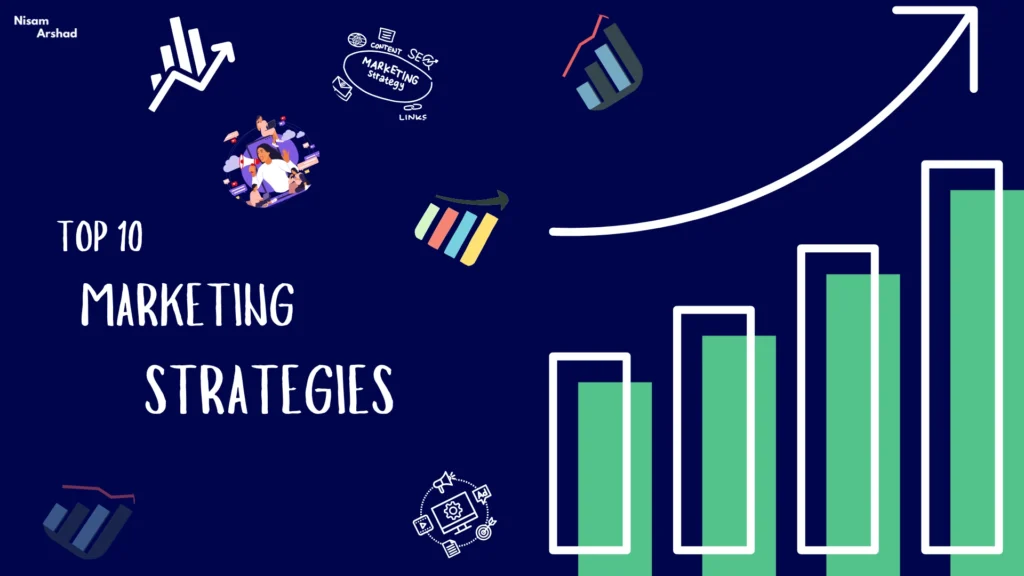As we edge closer to 2024, the marketing landscape is rapidly evolving, driven by technological advancements and shifts in consumer behavior. For businesses aiming to thrive in this dynamic environment, adopting innovative marketing strategies is essential. This comprehensive guide will delve into ten key marketing strategies that can help elevate your business in 2024. By understanding and implementing these strategies, you can navigate the complexities of the modern marketplace and achieve sustained growth.
Embracing AI and Automation
Artificial Intelligence (AI) and automation are no longer futuristic concepts but integral components of contemporary marketing strategies. AI is revolutionizing how businesses interact with customers by analyzing vast amounts of data to deliver actionable insights. These insights can help predict trends, personalize interactions, and optimize marketing efforts. For instance, AI-driven chatbots can provide 24/7 customer support, answering queries and guiding users through the buying process with minimal human intervention.
Automation complements AI by handling repetitive tasks such as email marketing, social media management, and lead nurturing. Implementing these marketing strategies not only enhances efficiency but also ensures that customers receive timely and relevant communication. For example, automated email campaigns can be triggered based on user behavior, such as cart abandonment or previous purchases, to encourage conversions and foster customer loyalty.
Integrating AI and automation into your marketing strategies can drastically reduce the time and effort spent on manual, repetitive tasks. By automating these routine activities, your team can dedicate more time to focusing on high-level, strategic initiatives that drive innovation and competitive advantage. Furthermore, AI-powered tools can help deliver highly personalized experiences for customers, tailoring content, recommendations, and services to meet individual needs and preferences. This personalized approach not only enhances customer satisfaction but also boosts engagement and conversion rates. In the long run, these AI-driven enhancements contribute to improved efficiency, greater productivity, and sustained business growth.
The Power of Video Marketing

Video marketing has become a cornerstone of digital strategy, and its significance is set to grow even further in 2024. As consumer preferences shift towards visual content, incorporating video into your marketing efforts is crucial for capturing attention and driving engagement. Video content, whether it’s short-form videos for social media platforms like TikTok and Instagram or longer, in-depth tutorials on YouTube, can effectively communicate your brand’s message and showcase your products or services.
Creating captivating video content might help you establish stronger ties with your viewers.Live streaming events, product demonstrations, and customer testimonials are powerful tools for building trust and enhancing brand visibility. Moreover, video content can drive higher conversion rates by providing potential customers with a clearer understanding of your offerings and how they address their needs.
Incorporating video into your marketing strategy involves not only creating high-quality content but also optimizing it for various platforms. This includes tailoring video length and format to suit the preferences of your target audience and leveraging SEO best practices to improve discoverability.
Harnessing Influencer Marketing
Influencer marketing remains a potent strategy for reaching new audiences and establishing credibility. As we move into 2024, the focus is shifting towards micro and nano-influencers—individuals with smaller but highly engaged and niche followings. Unlike traditional celebrity endorsements, these influencers often offer more authentic and impactful interactions with their audiences.
partnering with micro and nano-influencers offers a powerful way for your brand to tap into niche communities and build trust among potential customers. Unlike larger influencers, micro and nano-influencers tend to have smaller but highly engaged followings, making them more relatable and accessible to their audience. Their followers often perceive their endorsements as more genuine and credible, leading to higher levels of trust in the products or services they promote. This authenticity can result in more meaningful connections with your target audience and ultimately drive higher conversion rates.
Collaborations with these influencers can take on various forms, such as sponsored content, in-depth product reviews, and exciting giveaways that encourage audience participation. By creating engaging, personalized content with influencers who align with your brand’s values and mission, you can foster a sense of community around your products and services. This type of partnership not only helps to increase brand awareness but also enhances audience engagement and loyalty.
Over time, these authentic collaborations can help your brand build a dedicated customer base, generating long-term business growth and a stronger online presence.To maximize the impact of influencer marketing, focus on selecting influencers who have a genuine connection with their audience and whose content resonates with your target market. Building long-term relationships with these influencers can also lead to more meaningful and sustained results.
Optimizing for Voice Search

The rise of voice-activated devices such as Google Home, Alexa, and Siri has transformed how consumers search for information online. Query types for voice search are typically more conversational and organic than those for regular text-based searches.To stay ahead in this evolving landscape, businesses must optimize their content for voice search.
Optimizing for voice search involves focusing on long-tail keywords and providing direct answers to common questions. Voice searches often involve questions like “What are the best restaurants near me?such as “What is the best way to fix a leaky faucet?” Your work should therefore address these issues in a clear and succinct manner. Incorporating schema markup can also help search engines understand and present your content more effectively, improving your visibility in voice search results.
Additionally, ensuring that your website is mobile-friendly and has fast loading times is crucial for capturing voice search traffic. Voice search users are typically on the go and expect quick, relevant answers. By optimizing your site for these factors, you can enhance the user experience and improve your chances of appearing in voice search results.
Personalization and Customer Experience

In today’s digital age, consumers expect personalized interactions that cater to their individual preferences and needs. Personalization goes beyond simply addressing customers by name; it involves tailoring content, offers, and experiences based on their behavior and preferences.
Leveraging Customer Relationship Management (CRM) systems and AI tools can help you deliver personalized experiences across various touchpoints. For instance, personalized email campaigns that offer relevant product recommendations based on previous purchases or browsing behavior can significantly enhance engagement and drive conversions. Similarly, personalized website experiences, such as dynamic content and tailored offers, can improve user satisfaction and foster long-term loyalty.
Prioritizing customer experience involves not only personalization but also ensuring that interactions are seamless and enjoyable. By focusing on creating a positive and personalized experience, you can build stronger relationships with your customers and encourage repeat business.
Leveraging User-Generated Content
User-generated content (UGC) has emerged as one of the most valuable assets in modern marketing, offering brands an authentic and credible way to connect with their audience. Unlike traditional advertising, UGC is content created by real customers, often in the form of reviews, testimonials, social media posts, photos, and videos, that showcase their genuine experiences with a product or service. This type of content acts as powerful social proof, helping to build trust and credibility with potential customers who are more likely to trust the opinions of their peers over polished brand messaging.
By incorporating UGC into marketing strategies, brands can tap into the voice of their customers to enhance their authenticity and relatability. Potential buyers are often influenced by the experiences and feedback of others, making UGC a critical element in shaping purchase decisions. Additionally, UGC fosters a sense of community, allowing customers to feel more involved and connected to the brand. It creates a two-way interaction where brands not only share their message but also actively engage with their audience.
Beyond building trust, UGC also boosts engagement. Social media platforms, in particular, thrive on user interactions, and featuring UGC encourages further participation, as customers are excited to see their content shared by the brands they love. Whether through contests, hashtag campaigns, or customer shout-outs, UGC helps generate buzz and increases organic reach. Moreover, UGC is highly cost-effective, as it reduces the need for constant content creation by the brand itself, relying instead on the creativity and enthusiasm of its customer base.
Incorporating UGC into your marketing efforts not only provides social proof but also helps humanize your brand, making it more approachable and trustworthy. Ultimately, leveraging UGC can lead to increased engagement, higher conversion rates, and stronger customer loyalty, driving long-term growth and success for your business.
Encouraging your customers to share their experiences and featuring their content on your platforms can amplify your brand’s reach and credibility. For example, running social media contests or using branded hashtags can motivate users to create and share content related to your brand. Highlighting this content on your website or social media channels can enhance your brand’s authenticity and appeal.
To maximize the impact of UGC, consider implementing strategies that incentivize customers to share their experiences, such as offering discounts or rewards. Additionally, actively engaging with users who create content about your brand can help strengthen relationships and foster a sense of community.
Embracing Sustainability and Social Responsibility

Consumers, particularly younger generations, are increasingly drawn to brands that demonstrate a commitment to sustainability and social responsibility. In 2024, showcasing your business’s initiatives in these fields will help you stand out from the competition and win over socially conscious customers.
Showcasing your commitment to sustainability can involve adopting eco-friendly practices, supporting charitable causes, or using sustainable materials. For example, if your business implements recycling programs, reduces carbon emissions, or supports local communities, make sure to communicate these efforts through your marketing channels.
Demonstrating social responsibility not only enhances your brand’s reputation but also attracts loyal customers who share your values. By aligning your brand with ethical practices and social causes, you can build stronger connections with your audience and differentiate yourself in a competitive market.
Harnessing Data-Driven Marketing
Data-driven marketing is essential for crafting effective strategies in 2024. Businesses can learn important information about the behavior, tastes, and trends of their customers by evaluating data from a variety of sources.This information enables more informed decision-making and targeted marketing efforts.
Utilizing analytics tools to track customer interactions, segment audiences based on data, and continuously test and optimize campaigns can significantly enhance your marketing performance. Data-driven strategies allow you to identify which channels, messages, and tactics are delivering the best results and adjust your approach accordingly.
For instance, analyzing user behavior on your website can help you understand which content resonates most with your audience and which areas need improvement. Similarly, tracking the performance of your marketing campaigns can provide insights into which strategies are most effective and where you should allocate your budget.
Developing a Robust Content Marketing Strategy

Content marketing remains a cornerstone of successful Marketing strategies. High-quality, relevant content helps establish your brand as an authority, drive traffic, and engage your audience throughout their buyer’s journey.
A robust content marketing strategy involves creating a mix of blog posts, videos, infographics, and other formats tailored to your audience’s interests. Organizing content into pillars and clusters can improve SEO and enhance user experience. For example, developing pillar content on key topics related to your industry and creating supporting content that links back to these pillars can drive traffic and improve search rankings.
Additionally, regularly updating and optimizing your content to reflect the latest trends and insights can help maintain its relevance and effectiveness. By providing valuable and engaging content, you can attract and retain your target audience, build brand authority, and drive conversions.
Investing in Omnichannel Marketing
In 2024, consumers expect a seamless experience across various touchpoints, whether they’re interacting with your brand online, through social media, or in-store. Omnichannel marketing ensures that your messaging and branding are consistent across all channels, creating a unified customer journey.Integrating online and offline efforts, managing campaigns with omnichannel tools, and providing cohesive experiences across platforms are crucial marketing strategies for strengthening your brand’s presence.
For instance, if a customer engages with your brand on social media and later visits your website, they should encounter a consistent message and experience that reinforces their engagementEffective omnichannel marketing strategies involve using data to track and analyze customer interactions across different channels, allowing you to provide personalized and relevant experiences. By ensuring consistency and continuity in your marketing efforts, you can enhance customer satisfaction and drive brand loyalty.
Conclusion
The marketing landscape of 2024 presents both challenges and opportunities for businesses seeking growth. By embracing these strategies—ranging from AI and automation to omnichannel marketing—you can navigate the complexities of the modern marketplace and achieve sustained success. Each strategy plays a crucial role in building a strong, competitive presence, and adapting to these trends will help you stay ahead of the curve.
As you plan your marketing efforts for the coming year, consider how these strategies align with your business goals and customer needs. Continuously optimizing your approach and staying informed about the latest developments will set you on the path to achieving your marketing objectives and driving long-term growth.
